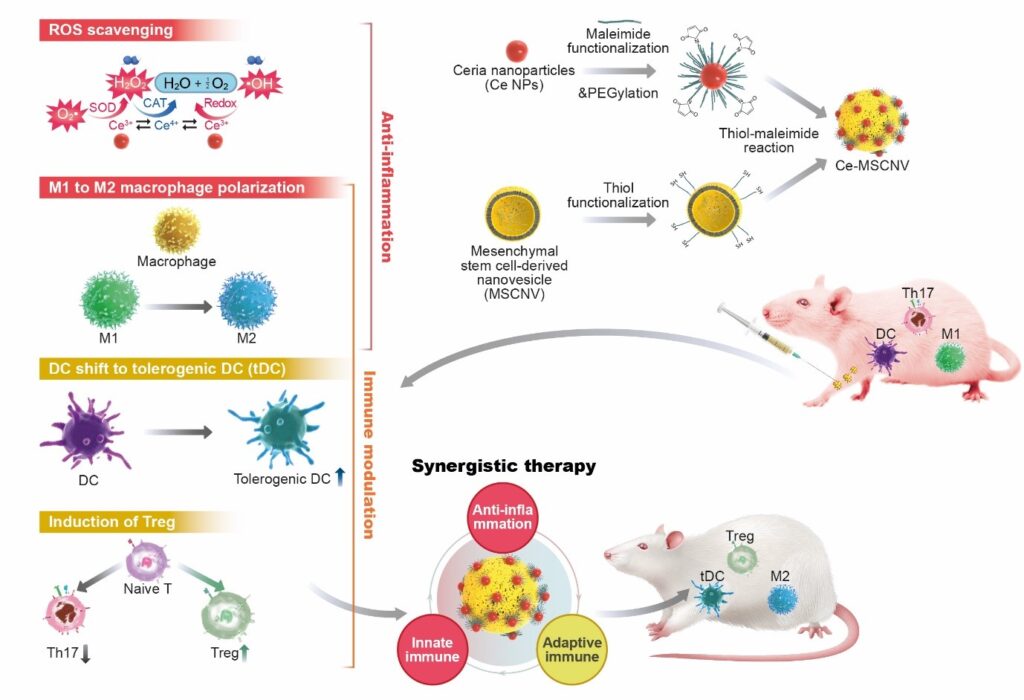An October 26, 2023 news item on phys.org announced a possible new treatment for rheumatoid arthritis (RA), Note: Links have been removed,
A team of scientists [Korea] has developed a new solution for the treatment of rheumatoid arthritis (RA). The work has been published in Nature Nanotechnology.
RA is a chronic disease that, unfortunately, has no cure. The disease triggers a mix of troublesome symptoms like inflamed joints, harmful cytokines, and immune system imbalances, which work together to create a relentless cycle of worsening symptoms. While targeting some of these factors can provide short-term relief, others remain unresolved, leading to a frustrating cycle of remission and flare-ups.
One of the major hurdles in RA treatment is the inability to restore the immune system to its healthy state. This leaves the body unable to control the continuous production of harmful substances like reactive oxygen species (ROS) and inflammatory cytokines, leading to persistent inflammation and discomfort.
In essence, the ideal treatment for RA should not only provide immediate relief from inflammation and symptoms but also address the root cause by restoring the immune system to its normal, balanced state.
New nanoparticle-based system as a solution
The new platform involves immobilizing ceria nanoparticles (Ce NPs) onto mesenchymal stem cell-derived nanovesicles (MSCNVs). Both of these components can hinder different pathogenic factors, allowing them to work both individually and cooperatively to achieve a comprehensive treatment.
…

An October 27, 2023 Institute for Basic Science (IBS) press release (also on EurekAlert but published October 26, 2023), which originated the news item, provides more details about the proposed treatment,
Ce NPs – can scavenge the overproduced ROS in RA-inflicted knee joints. They also induce polarization of M1 macrophages into M2, achieving immediate relief of inflammation and symptoms.
MSCNVs – deliver immunomodulatory cytokines, which turn dendritic cells (DC) into tolerogenic dendritic cells (tDCs). This consequently generates regulatory T cells for long-term immune tolerance.
In short, this approach aims to bridge both innate and adaptive immunity to achieve both short-term pain relief, as well as convert the tissue environment into an immune-tolerant state to prevent the recurrence of symptoms.
Researchers confirmed the efficacy of this approach using a collagen-induced arthritis mouse model. The Ce-MSCNV system was able to comprehensively treat and prevent RA by simultaneously relieving the immediate and restoring T cell immunity. Supporting data suggest that improvement in conditions can be achieved after only a single-dose treatment.
The mice treated with the Ce-MSCNV combination fared far better compared to the ones only treated using the Ce NP or MSCNV group. This clearly demonstrates the synergy between anti-inflammation and immunomodulation and underlines the importance of the combined therapy for effective RA treatment. In addition, Ce-MSCNV administration prior to booster injection markedly reduced the incidence and severity of symptoms, supporting the prophylactic potential of these nanoparticles.
First author KOO Sagang stated, “One of the hardest decisions in intractable disease therapy is determining how long the treatment should be carried on. For RA, it would not be appropriate to stop treatment just because the target marker is stabilized. A safer indicator should be that the innate and adaptive components of the collapsed immune system are normalized to protect the body.”
Koo believes that the strategy adopted by Ce-MSCNVs, where different treatment mechanisms work together, provides a unique advantage in this regard. Furthermore, she predicts that a similar approach would also be applicable to other intractable, inflammatory, and autoimmune diseases for this purpose. The components within the system may also be modified. For example, other catalysts for generating ROS or other cell-derived nanovesicles could be utilized depending on the types of diseases. Overall, this study proves the potential of a hybrid nanoparticle system for the comprehensive treatment of autoimmune disease and modulation of the immune system.
Here’s a link to and a citation for the paper,
Ceria-vesicle nanohybrid therapeutic for modulation of innate and adaptive immunity in a collagen-induced arthritis model by Sagang Koo, Hee Su Sohn, Tae Hee Kim, Siyeon Yang, Se Youn Jang, Seongryeol Ye, Boomin Choi, Soo Hyeon Kim, Kyoung Sun Park, Hyun Mu Shin, Ok Kyu Park, Cheesue Kim, Mikyung Kang, Min Soh, Jin Yoo, Dokyoon Kim, Nohyun Lee, Byung-Soo Kim, Youngmee Jung & Taeghwan Hyeon. Nature Nanotechnology (2023) DOI: https://doi.org/10.1038/s41565-023-01523-y Published: 26 October 2023
This paper is behind a paywall.